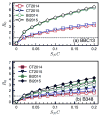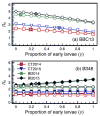Co-feeding transmission facilitates strain coexistence in Borrelia burgdorferi, the Lyme disease agent
- PMID: 28089780
- PMCID: PMC5474356
- DOI: 10.1016/j.epidem.2016.12.002
Co-feeding transmission facilitates strain coexistence in Borrelia burgdorferi, the Lyme disease agent
Abstract
Coexistence of multiple tick-borne pathogens or strains is common in natural hosts and can be facilitated by resource partitioning of the host species, within-host localization, or by different transmission pathways. Most vector-borne pathogens are transmitted horizontally via systemic host infection, but transmission may occur in the absence of systemic infection between two vectors feeding in close proximity, enabling pathogens to minimize competition and escape the host immune response. In a laboratory study, we demonstrated that co-feeding transmission can occur for a rapidly-cleared strain of Borrelia burgdorferi, the Lyme disease agent, between two stages of the tick vector Ixodes scapularis while feeding on their dominant host, Peromyscus leucopus. In contrast, infections rapidly became systemic for the persistently infecting strain. In a field study, we assessed opportunities for co-feeding transmission by measuring co-occurrence of two tick stages on ears of small mammals over two years at multiple sites. Finally, in a modeling study, we assessed the importance of co-feeding on R0, the basic reproductive number. The model indicated that co-feeding increases the fitness of rapidly-cleared strains in regions with synchronous immature tick feeding. Our results are consistent with increased diversity of B. burgdorferi in areas of higher synchrony in immature feeding - such as the midwestern United States. A higher relative proportion of rapidly-cleared strains, which are less human pathogenic, would also explain lower Lyme disease incidence in this region. Finally, if co-feeding transmission also occurs on refractory hosts, it may facilitate the emergence and persistence of new pathogens with a more limited host range.
Keywords: Borrelia; Co-feeding; Coexistence; Ixodes scapularis; Lyme disease; Pathogen diversity.
Copyright © 2016 The Authors. Published by Elsevier B.V. All rights reserved.
Conflict of interest statement
We have no competing interests.
Figures






Similar articles
-
Incorporating tick feeding behaviour into R0 for tick-borne pathogens.Theor Popul Biol. 2020 Feb;131:25-37. doi: 10.1016/j.tpb.2019.10.004. Epub 2019 Nov 12. Theor Popul Biol. 2020. PMID: 31730874 Free PMC article.
-
Closely-related Borrelia burgdorferi (sensu stricto) strains exhibit similar fitness in single infections and asymmetric competition in multiple infections.Parasit Vectors. 2017 Feb 6;10(1):64. doi: 10.1186/s13071-016-1964-9. Parasit Vectors. 2017. PMID: 28166814 Free PMC article.
-
Genetic variation in transmission success of the Lyme borreliosis pathogen Borrelia afzelii.Ticks Tick Borne Dis. 2015 Apr;6(3):334-43. doi: 10.1016/j.ttbdis.2015.02.007. Epub 2015 Mar 4. Ticks Tick Borne Dis. 2015. PMID: 25748511
-
Tick-host-pathogen interactions in Lyme borreliosis.Trends Parasitol. 2007 Sep;23(9):434-8. doi: 10.1016/j.pt.2007.07.001. Epub 2007 Jul 25. Trends Parasitol. 2007. PMID: 17656156 Review.
-
[Ixodes ricinus, transmitted diseases and reservoirs].Parassitologia. 2004 Jun;46(1-2):119-22. Parassitologia. 2004. PMID: 15305699 Review. Italian.
Cited by
-
Vector competence studies with hard ticks and Borrelia burgdorferi sensu lato spirochetes: A review.Ticks Tick Borne Dis. 2020 May;11(3):101359. doi: 10.1016/j.ttbdis.2019.101359. Epub 2019 Dec 14. Ticks Tick Borne Dis. 2020. PMID: 32067949 Free PMC article. Review.
-
Lyme Disease Models of Tick-Mouse Dynamics with Seasonal Variation in Births, Deaths, and Tick Feeding.Bull Math Biol. 2024 Jan 31;86(3):25. doi: 10.1007/s11538-023-01248-y. Bull Math Biol. 2024. PMID: 38294562
-
Co-infection of tick-borne bacterial pathogens in ticks in Inner Mongolia, China.PLoS Negl Trop Dis. 2023 Mar 9;17(3):e0011121. doi: 10.1371/journal.pntd.0011121. eCollection 2023 Mar. PLoS Negl Trop Dis. 2023. PMID: 36893172 Free PMC article.
-
Incorporating tick feeding behaviour into R0 for tick-borne pathogens.Theor Popul Biol. 2020 Feb;131:25-37. doi: 10.1016/j.tpb.2019.10.004. Epub 2019 Nov 12. Theor Popul Biol. 2020. PMID: 31730874 Free PMC article.
-
Borrelia burgdorferi chemotaxis toward tick protein Salp12 contributes to acquisition.Ticks Tick Borne Dis. 2019 Aug;10(5):1124-1134. doi: 10.1016/j.ttbdis.2019.06.002. Epub 2019 Jun 8. Ticks Tick Borne Dis. 2019. PMID: 31204044 Free PMC article.
References
-
- Andersson M, Scherman K, Raberg L. Multiple-strain infections of Borrelia afzelii: a role for within-host interactions in the maintenance of antigenic diversity? Am Nat. 2013;181(4):545–554. - PubMed
-
- Brunner JL, Ostfeld RS. Multiple causes of variable tick burdens on small-mammal hosts. Ecology. 2008;89(8):2259–2272. - PubMed
-
- Crippa M, Rais O, Gern L. Investigations on the mode and dynamics of transmission and infectivity of Borrelia burgdorferi sensu stricto and Borrelia afzelii in Ixodes ricinus ticks. Vector Borne Zoonotic Dis. 2002;2(1):3–9. - PubMed
-
- Davis S, Bent SJ. Loop analysis for pathogens: niche partitioning in the transmission graph for pathogens of the North American tick Ixodes scapularis. J Theor Biol. 2011;269(1):96–103. - PubMed
MeSH terms
Grants and funding
LinkOut - more resources
Full Text Sources
Other Literature Sources
Medical

